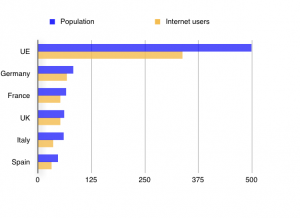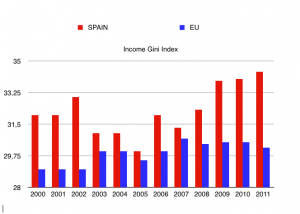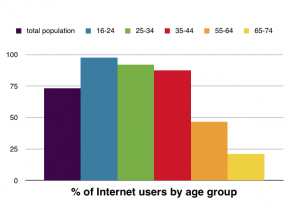This article intends to justify why is Spain an equitable information society by analyzing the global context of the ICT. Emphasises the key importance of Gini index and its relation with the equality as well as it has been measured the percentage of Internet users per habitat size, the percentage of Internet users by level of education, the percentage of Internet users by group of age, and the percentage of internet users by activity status. It also merges concepts and approaches from the most relevant authors in the fields of technology, economics and media. David Guardo Puertas. Master of Science in Communication Studies. Studies of Media, Information and Telecommunication. January 2014. (Download PDF Format here: Is my country an equitable information society. New Media and Society)
Introduction
The fact that the last technological revolution has changed the life of the mankind forever seems to be pretty understandable for everybody, not only concerning either the academic world or business models but the whole spectrum of the global citizenship. Nevertheless, the way to predict how this revolution is able to alter the habits, behaviour, idiosyncrasy, conducts or manners of the world population is still challenging.
Inequality and social exclusion are very sensitive issues that require to be researched under a multidisciplinary prism. Furthermore, if we add the variable of new information societies, the challenge is much greater. Inequality itself has been investigated in the fields of development economics using the Gini Index, for example; in other cases, we have proceeded to the analysis of consumption statistics provided by government, agencies, etc. In any case, in this article both routes will be used to build a constructive view with objective information, and also will proceed to the inclusion of certain renowned authors in the fields of technology, economics and media.
Nowadays, inside a modern society the fact of being equal and having the same rights and opportunities rest on the pillars of most country´s constitution and fundamental standards in the western world. However, it does not mean it operates always in a satisfactory, neutral or democratic way. Not even in the European Union where the rate of social inequality has been systematically increasing and the general values of UE such as social progress, balanced economic growth and full employment are losing cohesion. In order to answer the question of why Spain is an equitable information society, firstly, it is necessary to define what we mean by “equity” in an information society. And then define it in economic terms.
– Does the population of Spain have the same opportunities to get access to new the technologies of information?
– Which are the levels of income that affect consumption in an information society? And with regard to the levels of education?
– Are there any significant differences between the percentage of Internet users who live in large cities and those who live in small towns?
Giving an answer to those questions might help confirm the main hypothesis. Besides, this article explores and analyses briefly the current context of the information society in Spain and intends to justify the considerations of why Spain is an equitable information society and its position in the world´s global trends from the point of view of the telecommunications and the Internet.
The starting point of this article coexist with, approximately, during the coming of the Post- Industrial Society (Bell, 1973) coinciding simultaneity in time with Pérez´s approaches based on the fifth technological revolution. Along this study the terms of equality, transparency and development will be examined in the context of the arrival of new technologies as well as its impact in the society from the past few years. An important question to take into consideration is that post industrial societies emerge though social structure rather than politics or culture (Bell, 1973).
1. Evolution, Equality and Transparency of the Information Society and Connectivity in Spain
This section contains three aspects that are considered relevant to answer the question of why is Spain an equal information society. In the first section, it has been analysed the evolution of information technology and the latest inclinations on consumption, both internationally and in the Spanish market. The research contextualizes Spain in the global world.
Moreover, in the next section, the issue of equality comes from the perspective of development economics; in this regard income inequality is analysed and understood in the way it can affect social exclusion inside the Spanish society.
In conclusion, the paragraph Transparency is from the point of view of the state, in the sense of the measures that can be taken in order to generate a beneficial impact on society and implement the Draft Law on Transparency, Access to Information and Good Governance.
1.1 Evolution
It can be argued that the Information Society in the world continues to move forward despite the difficult global economic situation in western countries. At one point helped by the significant increase of users of the Internet of the BRIC countries (Brazil, Russia, India and China) leading the growth in the ICT sector. For example, in 2012 the BRIC countries experienced an increase of 9% in a year.
Virtually 2.300 million people were already connected in late 2011 to the Internet which represents the 32.5% of the world population. In addition, nearly 6,000 million subscribers of mobile lines show a penetration of 85.7 lines per 100 inhabitants, compared to 78 lines per 100 inhabitants in 2010. However, there are still remaining significant regional differences. The percentage of people using the Internet in developed countries reached 70% in late 2011 while only a quarter of the population of the developing countries had access to the Internet. In relation to mobile phone use, penetration grew in a very fast way in developing countries, where were signed more than 80% of the 660 million new mobile lines recorded in 2011. The growth of broadband in the world is clearly led from the year 2009 by increasing the connections of mobile broadband, which in 2011 grew 40 % over the year 2010 to 15.7 lines per 100.
It is widely recognized that the economic situation in Spain is troubled. For instance, the 27% unemployment rate does not decrease; the debt of the state constitutes the 100% of the G.D.P plus the poverty rate rises till the 21% of the population this year, etc; in addition there is not a single indicator which provides confidence for 2014, not even one. As a result, the country has turned as one of the most unequal countries in the EU but paradoxically this fact, does not seem to have a negative impact on the consumption in the information society
The Chart 1.1 shows the relationship between community and internet users within the 5th biggest economies in the European Union.
Chart 1.1
Source: own elaboration based on National Statistics Institute
In 2012, in Spain there were 24 million Internet users, almost a million more than in 2011. 72.6% of them were accessing every day, having an increase of 1.2% more than in 2011. The most significant growth has occurred with the penetration of Internet access through smartphones, which grew up 17.5% from 2010, to mid-2012 at 42.6 %. In 2011 the number of lines associated with a fee to access mobile Internet reached 15.9 million, in mid- 2012 exceeded 19.7million. In the area of fixed broadband, penetration stood in mid-2012 at 24.2 lines per 100 inhabitants.
1.2 Equality and… Exclusion?
The following chapter aims to demonstrate that a country with high levels of inequality can be equitable within the new horizons of information societies (equality in economic terms). According to the fifth technological revolution explained by Carlota Perez, it is possible that the Techno -economic paradigms such as heterogeneity, diversity, adaptability, and globalization – interaction between the global and the local, etc. may represent a revolutionary element in favor of social inclusion in developing countries or those most unequal countries in western nations.
In this instance, an equitable society is considered one in which the citizens live in a democracy, have equal opportunities, there is no discrimination based on religion, race or gender and where wealth is equally distributed. If we try to define what an equitable information society is, it can be seen as that in which citizens can access the new technology, no matter the geographic location, the age, the income or educational level.
Therefore, in order to place Spain in an economic scene and to evaluate the equality and possible social exclusion levels it is necessary to use the Gini coefficient in a global context. Gini coefficient is commonly used as a measure of inequality of income, showed from 0 to 1, where 0 means perfect equality and 1 maximal inequality.
Chart 1.2
Source: own elaboration based on National Statistics Institute
The United Nations Development Program published in 2010 a review where explains that the coefficient estimates how effectively a society enables its citizens to achieve success in life, where understanding that success is based on a person’s choices, efforts and talents, and not on his background defined by a set of predetermined circumstances at birth, such as, gender, race, place of birth, parent’s income and any other circumstances beyond the control of that individual (Kovacevic, 2010). So according to this view an equal society might avoid power concentration and a non democratic scenario. Castells states that the independence of the social organization increases over time with technological change and thanks to the evolution of communication technologies, and as a result, the society steps forward with self-determination an autonomy of the power concentration.
According to this point of view it is also argued that Italy and Spain are the largest opportunity inequality Gini index amongst advanced economies as Roemer showed in his publication in 2006, Economic Development as an opportunity of equalization.
Charts 1.3
Source: own elaboration based on National Statistics Institute
The Chart 1.3 shows, about 73% of the total population using Internet, the breakdown by size number of townsmen. The maximum gap is observed between large cities with more than 100,000 inhabitants and towns with fewer than 10,000 inhabitants that varies by 10 points. This variation is largely because Spain is a country with a large expanse of territory (second largest country in the EU) and its complex geomorphology. However, from between 10,000 and 20,000 people, is observed that there is harmony and consistency with the trends of the rest of the population.
Charts 1.4
Source: own elaboration based on National Statistics Institute
The Chart 1.4 clearly shows the highest concentration of Internet users ages from 16 years to 44, consumption drops dramatically, from 86% to 40% users in the 55-64 period, and to over 65 and less than 20% use.
Chart 1.5
Source: own elaboration based on National Statistics Institute
In terms of education levels, higher, pre university and secondry education area are basically the. On the contrary, marginal level is observed with a sharp decline in the percentage of people with primary education.
Chart 1.6
Source: own elaboration based on National Statistics Institute
The graphics analyzed displays some cohesion in the overall population, such as young people and up to 55 years old, those who have higher educational studies, have a job or are unemployed; they all use the internet daily. However, we may speak of exclusion in the new era of information with regard to people with primary educational level or pensioners; this group does not use substantially Internet.
In general, as the graphs show it can be stated that there are equity and therefore equal opportunities for the Spanish population in the new information society but like any model, nothing is perfect. A marginal group is people with low education and those over 55, where access and consumption drop dramatically. This conclusion is in accordance with the statement Castells “more jobs are created, and most displaced workers are re-employed, except for those too old to adapt, their fate being decided depending on public policies in each society.” And in line with the public policies is based the next chapter.
1.3 Transparency
One characteristic of democracy in western countries is the transparency of its governments and governments become transparent thanks to the development of Internet. In the case of Spain, the central government launched in 2012 three relevant actions:
• Draft Law on Transparency, access to Information and good governance.
• Strategic Plan for Improving Public Service and Administration 2012-2015.
• Digital Agenda: improving the transparency of government.
It can be argued that all these actions contribute to form a participatory and inclusive society.
Conclusions
To conclude the article the fact remains that has not been an easy task to justify that the information society in Spain is equal when dealing with one of the most unequal countries in the eurozone, however, statistics showed access, inclusion and government programs already designed to prevent situations of marginality in older people or people with low education levels. From another perspective, and taken this idea(as a final reflexion) from the book Abundance: The future is better that you expect we can be displayed for the United States where people below the poverty line (more than 20 percent of the U.S. population) 99 percent have electricity, water, flushing toilets and a refrigerator; 95 percent have a television; 88 perfect have a telephone and 71 percent have a car…
“This may not seem like much, but one hundred years ago men like Henry Ford and Cornelius Vanderbilt were among the richest on the planet, but they enjoyed few of these luxuries.” (Diamantis, 2013)
And also it could have been interesting to mention from the author´s point of view that the 81% of the population in the United States of America is successfully connected daily.
Bibliography
– Webster, F (2006). Theories of the Information Society (3th edition), Sage Publications, Chapter 3. Post Industrial Sociesty (pp. 32- 59
-International Telecommunication Union (2013). Measuring the Information Society CH-1211 Geneva Switzerland, English. International Telecommunication Union.
-Fundación Telefónica (2013) Sociedad de la información en España 2012. Editorial Ariel S.A. 2013. Capítulo 1.5 Administración y gobiernos se hacen transparentes gracias a Internet.
-OCDE(2011)Divided we stand, Why inequality keeo rising, OCDE publications
-Kovacevic, M (2010) «Measurement of Inequality in Human Development – A Review» United Nations Development Program. UNDP publications
– Roemer, J.E (2006). Economic Development as Opportunity Equialization. Cowles Foundation Discussion Paper No 1582. Yale University, 2006.
– Castells, M. (2004) Informationalism. Networks and the Network Society: A Theoretical Bueprint. In: Castells, M (ed) The Network Society. A cross-cultural perspective. Cheltanham: Edwars Elgar, pp. 3-48
– Castells, M. Cardoso, G. The Network Society: From Knowledge to Policy. Washington, DC. Johns Hopkins Center for Transatlantic Relations, 2005.
– Carlota Perez Technological revolutions and techno-economic paradigms 1 January 20, 2009
– Diamandis, P (2013) Abundance: The Future Is Better Than You Think. Amazon books.










